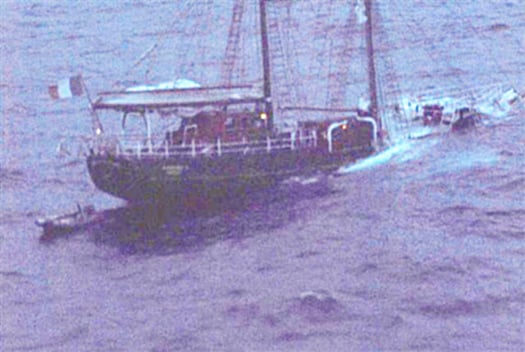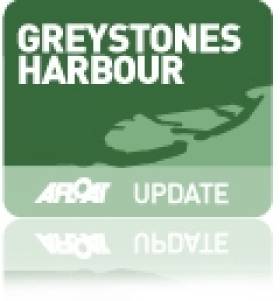Displaying items by tag: Afloat.ie
Colm Newport is Afloat's Sailor of the Month for April
Colm Newport was the Master of the sail training brigantine Asgard II when she started taking in water from an unexplained leak in the small hours of September 11th 2008 off the coast of France.
Like all Asgard's commanders during the ship's remarkable 27 year career which took her all over the world, he had a special affection for Asgard II, a small square rigger which punched way above her weight in the company of the world's largest tall ships.
But this was no occasion for sentimentality, and the sadness could wait until later. In a seamanlike manner, Newport analysed the reality of the situation, and calmly ensured that his full-rime crew and the ship's complement of young trainees clearly realized that the order to take up stations to abandon ship was for real – it wasn't simply an unexpected safety drill.

Asgard II sinks by the bow on September 11 2008 off the coast of France. Photo: Courtesy French Search and Rescue Service
To the credit of all on board, the transfer to the liferafts took place in a calm atmosphere, and as the beloved ship's final hour afloat arrived, Captain Newport gave the order to move away from the vicinity of the vessel to avoid any danger of the liferafts being dragged down by the rigging.
No-one was injured, few had any time even to be frightened, and thanks to the captain and crew's professional skill, the horror of drownings to wipe out Ireland's sail training programme was avoided.
Asgard II being a government-owned ship, the follow-through was inevitably slow. And as the national economic crash was getting up its full head of steam, the priorities of a national sail training programme open to all young people slipped right down the scale, until the Department of Defence quietly wound up Coiste an Asgard, and the insurance money for the ship went into the rapidly shrinking national coffers.
But the spirit lives on, and the newly established Sail Training Ireland – a voluntary body open to membership and all sorts of support – has been set up by several who were involved in Coiste an Asgard. It is officially recognized as the successor to the Asgard programme, and is already strengthened with bursaries from the global body Sail Training International.
In time, we may have a new square rigger, and she really will be the people's ship. But the fact that it can be anticipated with hope and enthusiasm is in large part due to the calm efficiency of Colm Newport and his crew on the morning of September 11th 2008.
Latest Asgard II Stories
Latest Tall Ships News from Ireland
80% of Berths Required in Greystones are Under 8 Metres
A newsletter giving details of the most popular size berth requirements at the proposed Greystones Harbour Marina has been sent to boat owners on a waiting list for the Wicklow marina.
The analysis finds 80% of the berths required are under 10 metres (32 foot). Only 2 berths were required for boats over 13m (42 feet).
In nearby Dun Laoghaire, at the country's biggest marina, the 820 berths there range in size from 6m (19 feet) to 30m (98 feet). The average berth requirement on Dublin Bay is 9-10m (29-32 feet).
The March newsletter says examination of the waiting list revealed duplication of an original waiting list which prompted a fresh exercise to establish the current market demand in 2011. The new survey of 300 people was carried out by a marina consultant, working for developer Sispar. It delivered 79 responses. An extract from the analysis is below.
The tabulation from the newsletter reflects the breakdown of the responses in terms of current berth size numbers and the extrapolation into the requirement for totals when fully developed based on to-days statistics.
| Berth Size | Numbers to 6/1/11 | % of Current Market | Full Dev Berth Nos. |
|
| <6m | 9 | 12.4 | 29 | |
| 6-7m | 12 | 15.2 | 35 | |
| 7-8m | 14 | 17.7 | 41 | |
| 8-9m | 5 | 6.3 | 15 | |
| 9-10m | 17 | 21.5 | 50 | |
| 10-11m | 8 | 10.1 | 24 | |
| 11-12m | 6 | 7.6 | 18 | |
| 12m-13m | 6 | 7.6 | 18 | |
| >13m | 2 | 2.6 | 5 | |
| Total | 79 | 101 | 235 |































































